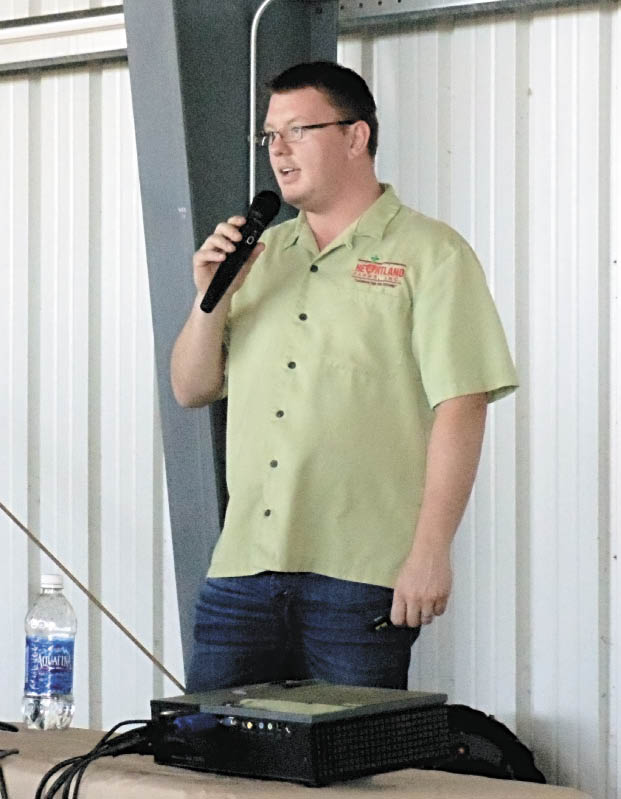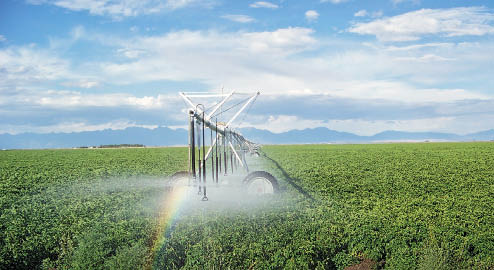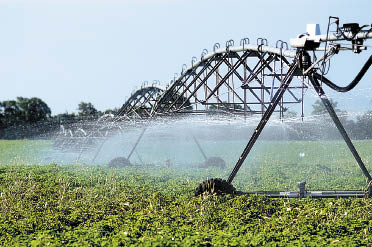 The bad news is that Wisconsin and much of the nation are suffering through one of the worst droughts in recent history.
The bad news is that Wisconsin and much of the nation are suffering through one of the worst droughts in recent history.
The good news is that today's science and technology along with advanced irrigation strategies used by Wisconsin potato and vegetable growers are reducing impacts on water supplies and helping to insure a safe, affordable, local food supply.
In the Driver's Seat
In an effort to work on the wide range of water issues facing agriculture, the Wisconsin Potato & Vegetable Growers Association (WPVGA) formed the Water Task Force-comprised of citizens, growers, industry leaders and scientists, and co-chaired by central Wisconsin farmers Nick Somers of Plover River Farms, Stevens Point, and Jeremie Pavelski of Heartland Farms, Inc., Hancock.
"Science, not opinion, should drive all discussions on water issues, beginning with a broad range of data collection," says Somers. "The more data we have, the more effective our water conservation practices will be. This is not just an issue in Central Wisconsin; there are water challenges all across the planet."
The vast majority of Wisconsin vegetable growers employ a variety of water conservation measures. Most importantly, growers only apply water when the crop needs it. Pavelski says that is the key to water conservation.
"We use prescription farming," Pavelski says. "We use all the tools at our disposal to help us apply only what the crop needs. We don't want to stress the crops by under-watering, but we don't want to overwater either. Overwatering would increase costs and would also increase the possibility of disease development and could lead to the leaching of valuable nutrients before the plants could absorb them."
Low-pressure irrigation systems are now the norm, using much less energy and less water than in the past. Drop nozzles are also used extensively, allowing the water to be applied closer to the ground, reducing the amount of evaporation that can take place.
Add in a sophisticated watering schedule that utilizes soil moisture testing and computerized irrigation systems, and you have high-tech farms making wise use of water. Using the grower-funded and research-based Wisconsin Irrigation Scheduling Program (WISP), a grower can use a soil probe to test the moisture of the soil and then use computer software to calculate what the crop needs. If it begins to rain during irrigation, the system is designed to pump only until a combination of rain and irrigation reaches that calculated crop need. Many irrigation systems can even predict the weather and the system will not irrigate if the forecast exceeds the crop needs.
"The next time you see an irrigation system applying water when it's raining, consider all the technology and planning that goes into water conservation and smart farming," Pavelski says. "Growers, their suppliers, and the banks that finance them have a strong interest in knowing exactly what is happening to the aquifer and water resources. We are regularly making multimillion dollar investments that will take 20 to 30 years to pay for. As prudent business people, we will not continue to make these huge investments if we will not have sufficient water to support them for generations to come. The very livelihood of our families and employees depend on these resources, and as people who have lived and farmed here for many generations, we fully understand that we need to protect these resources for our children, and their children."
Doing a Better Job
Though not everyone understands the complexities of the water cycle, groundwater recharge, and evapo-transpiration (ET), Wisconsin growers have to be experts on those subjects. That understanding is crucial to growing their crops and getting the highest yield with the least input of water and fertilizer.
Despite Wisconsin's large and plentiful underground aquifer, today's potato and vegetable growers use a number of research-based technologies to help them do a better job of water conservation. Just a few of the current projects funded by the growers of the WPVGA include:
� ET-based irrigation scheduling and its integration with database software;
� Landscape management for water recharge-documenting ET by crop;
� Deficit irrigation;
� Crop growth modeling and relationship to nutrient demand;
� Slow-release nitrogen fertilizers to reduce leaching;
� Managing drainage to hold water;
� Drip irrigation to improve water-use efficiency;
� Water quality relations to dairy systems;
� Groundwater monitoring wells.
Researchers are even exploring new varieties of crops that require lower amounts of water during peak need times. Over 200 wells are being monitored to help provide a scientific data bank on fluctuations in the groundwater.
The WPVGA also checks the accuracy of groundwater level mapping through sophisticated recording at 35 continuous monitoring sites. This information combined with the growers' monitoring data enables agencies, growers and communities to factually track and map the groundwater resource.
Across the Central Sands region of Wisconsin, nearly 100 percent of the potatoes are irrigated, as well as over half of all the processed vegetables (peas, beans and sweet corn). In short, the economic vitality of potato and vegetable production is directly tied to the success of irrigation.
And the economic impact of Wisconsin agriculture is staggering. Wisconsin ranks second in the nation in the production of processing vegetables and third in potato production. A 2011 study by the University of Wisconsin found that potato and vegetable production and processing provides the state with an economic impact of $6.36 billion annually. Additionally, the study found that there are 132,000 jobs in agricultural production.
"The impact of farming goes far beyond economics," Somers says. "We need to use the water to produce the food to feed the world. There's nothing more important."

